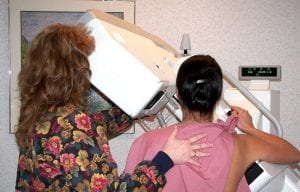Mammography
 Digital Mammograms
Digital Mammograms
A digital mammography exam usually takes less than half the time a of traditional film-based exam, and there is less of a chance you will be called back to retake your images.
Your physician will gain viewing options never before possible with the unique ability to enhance certain areas to get a more precise picture of your condition.
Your breast images can be zoomed in and out, and the contrast can be lightened or darkened. Also, through an inverting feature, black can reverse to white and white can change to black. This feature helps detect microcalcifications, which is like revealing a grain of salt in a ball of clay. All these image enhancements help improve diagnostic potential – and can be accomplished without your presence in the room.
Digital images give better visibility of the breast, particularly near the skin line, chest wall and in women with dense breast tissue. Also, digital images are helpful for women with implants and for imaging patients with known abnormalities.
When You Get a Mammogram
The procedure requires that you undress above the waist. A wrap for you to wear will be provided by the facility.
A technologist will be present to position your breasts for the mammogram. Most technologists are women. You and the technologist are the only ones present during the mammogram.
The whole procedure takes about 20 minutes. The actual breast compression only lasts a few seconds.
You may feel some discomfort when your breasts are compressed, but you should not feel pain. If your breasts are tender, as they may be just before your period, do not get a mammogram on that day. If the mammogram is painful, tell the technologist.
Only 1 or 2 mammograms of every 1,000 lead to a diagnosis of cancer.
If you are a woman aged 40 or over, you should get a mammogram every year. You can schedule the next one while you’re there at the facility and/or request a reminder.

